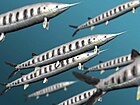
The Glypheoidea, is a group of lobster-like decapod crustaceans which forms an important part of fossil faunas, such as the Solnhofen limestone. These fossils included taxa such as Glyphea, and Mecochirus, mostly with elongated chelipeds. This group of decapods is a good example of a living fossil, or a lazarus taxon, since until their discovery in the 1970s, the group was considered to have become extinct in the Eocene. The superfamily Glypheoidea comprises five families. The two extant species, Neoglyphea inopinata and Laurentaeglyphea neocaledonica, are both in the family Glypheidae.

Caturus is an extinct genus of predatory marine fishes in the family Caturidae in the order Amiiformes, related to modern bowfin. It has been suggested that the genus is non-monophyletic with respect to other caturid genera.
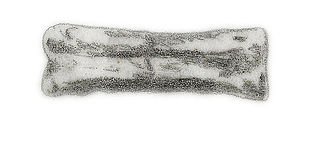
Teinurosaurus is a genus of carnivorous theropod dinosaur. Teinurosaurus lived during the Late Jurassic in what is now France. The type species is Teinurosaurus sauvagei. It's been estimated to be 11.4 m (37.4 ft) in length and 3.6 tonnes in weight.
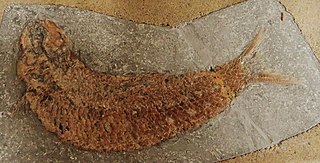
Pholidophorus is an extinct genus of stem-teleost fish. Numerous species were assigned to this genus in the past, but only the type species Pholidophorus latiusculus, from the Late Triassic of Europe, is considered to be a valid member of the genus today.

Leptolepis is an extinct genus of stem-teleost fish that lived in what is now Europe and North of Africa during the Jurassic period.

Pachythrissops is an extinct genus of ray-finned fish. It contains two species, P. laevis from the Purbeckian of England and P. propterus from the Tithonian of Germany. A third species, P. vectensis, has been reassigned to the elopiform genus Arratiaelops. Pachythrissops is often regarded as one of the most primitive members of the order Ichthyodectiformes; however, a phylogenetic analysis by Cavin et al. (2013) placed it and the related genus Ascalabothrissops outside the group.
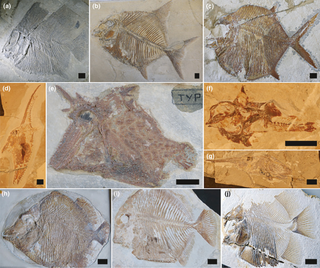
Pycnodontiformes is an extinct order of primarily marine bony fish. The group first appeared during the Late Triassic and disappeared during the Eocene. The group has been found in rock formations in Africa, Asia, Europe, North and South America.
Asiatoceratodus is an extinct genus of lungfish which lived during the Middle-Late Triassic, Jurassic and Cretaceous periods in what is now Asia (Kyrgyzstan), Africa and South America.
Baleiichthys is a genus of extinct freshwater ray-finned fish, belonging to the teleosts. It lived in the Middle Jurassic, and its fossil remains have been found in northern Asia. Almost nothing is known about it.
Aphnelepis is an extinct genus of prehistoric freshwater ray-finned fish that lived during the Late Jurassic epoch. It contains a single species, A. australis, from the Talbragar River beds of New South Wales, Australia.
Ligulella is an extinct genus of ray-finned fish that lived in what is now the Democratic Republic of the Congo during the Middle Jurassic epoch. It contains one species, Ligulella sluysi. Ligulella is the only member of the family Ligulellidae and the order Ligulelliformes.
Swenzia is an extinct genus of coelacanthid fish from the late Jurassic of France. It contains a single species, S. latimerae, which was originally described as Wenzia latimerae. Because the generic name Wenzia was already preoccupied by a snail, the generic name was amended to Swenzia. It is the fossil genus most closely related to the living coelacanth, Latimeria.

Anaethalion is an extinct genus of prehistoric marine and freshwater ray-finned fish related to modern tarpons and ladyfish. It is known from the Late Jurassic to the Early Cretaceous of Europe and northeasterrn Asia, roughly encompassing the Tethys Ocean.
Ceramurus is an extinct genus of prehistoric marine ray-finned fish from the Late Jurassic. It contains a single species, C. macrocephalus from the Purbeck Group of England.

Hulettia is an extinct genus of ray-finned fish known from United States. This fish genus contains two species, H. americana and H. hawesi.

Prohalecites is an extinct genus of ray-finned fish from the Ladinian and possibly Carnian (Triassic) of Italy. It is the oldest known teleosteomorph, a group that includes extant teleosts and their close fossil relatives.
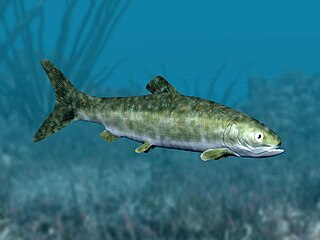
Ichthyokentema ("fish-goad") is an extinct genus of stem-teleost fish that lived during the Late Jurassic. It contains one species, I. purbeckensis, which is known from the Purbeck Group of Dorset, England. I. purbeckensis was originally described as a species of Pholidophorus by William Davies in 1887, but was moved to its own genus by Arthur Smith Woodward in 1941.

Orthogonikleithrus is a genus of extinct ray-finned fish that lived during the Late Jurassic period. It lived in lagoonal and restricted shallow subtidal zones.

Dorsetichthys is an extinct genus of stem-teleost ray-finned fish from the Early Jurassic period of Europe.














